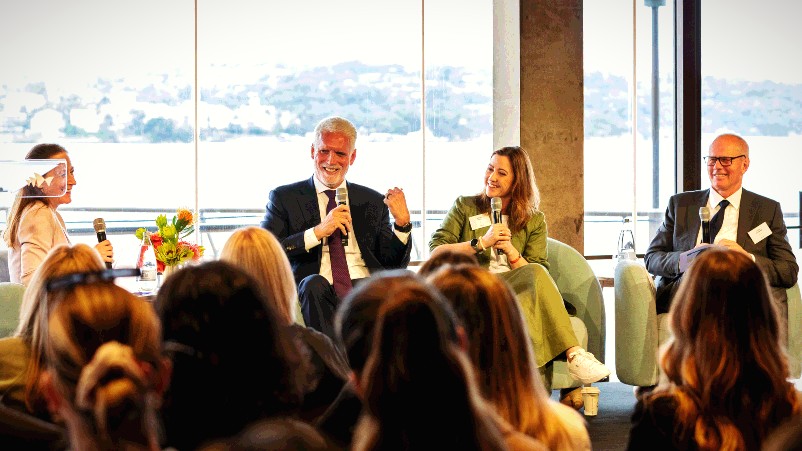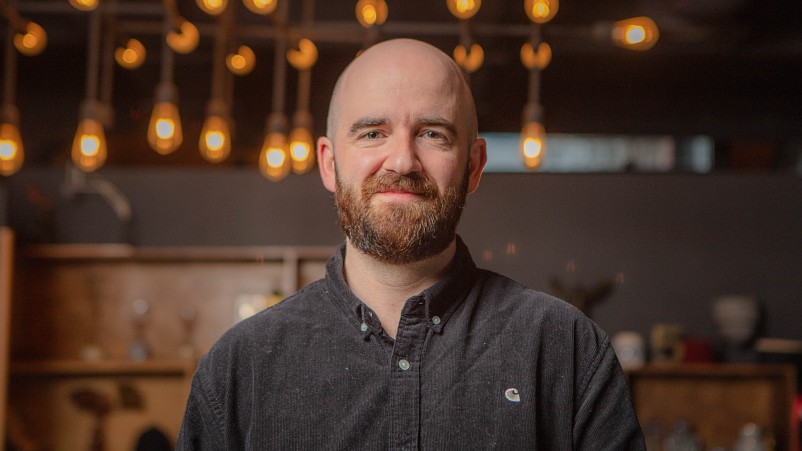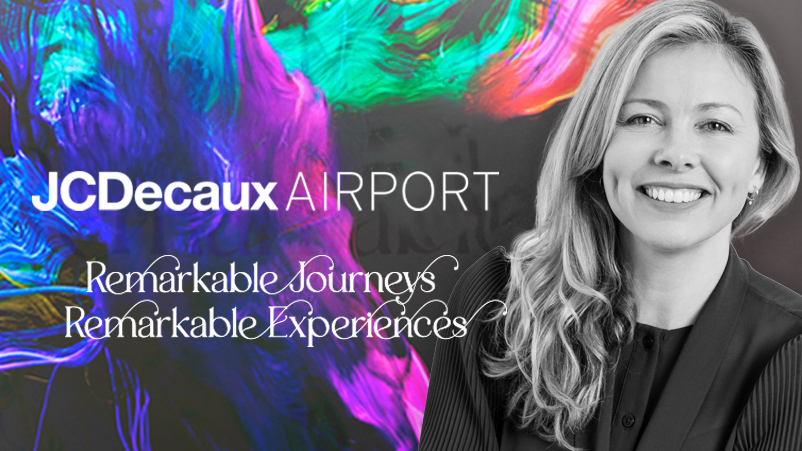Airports upgrade ad experience as passenger numbers soar, JCDecaux plots new course for journey-based media buying – MOVE 2.0 to unlock full funnel payload

From left: Mi3's Nadia Cameron, Sydney Airport's Scott Charlton, CPI's Susan Gray and JCDecaux's Steve O'Connor at the recent JCDecaux trade event in Sydney
Travel is now surpassing pre-pandemic levels – even amid an economic crunch – and airports are looking to up their CX act with millions in Capex outlay to refine the terminal experience. JCDecaux has taken the wrappers off a new ‘connected journey’ media buying proposition across Australian airports for brands plus new program options that go beyond the screen. With the final arrival of Move 2.0, it’s not just the OOH provider’s CEO who sees a more compelling full-funnel narrative in his sights – agencies are welcoming on the flight to better outcomes for brands.
What you need to know:
- Sydney Airport literally told its media providers “the sky is not the limit” on how they can use one of the world’s busiest airports. JCDecaux landed the competitive tender and is releasing a new suite of airport advertising solutions in the Australian market.
- The new products include a more connected journeys (versus precinct-based) buy, but also a raft of new open spaces and experiential opportunities to go ‘beyond the rectangle’ and that encourage more full-funnel thinking, says GM of airports, Jemma Enright.
- JCDecaux CEO ANZ, Steve O’Connor, meanwhile, expects the next iteration of the out-of-home industry’s unified measurement approach, MOVE 2.0, to further bolster airport advertising spend by finally including more comprehensive insight into the movement of travellers 365 days per year – as well as more neuroscience to understand their attention from curb to gate.
- The refreshed ad play comes as airports globally see the strength in better aligning commercial and Capex outlay to customer experience improvements that further encourage travellers to dwell longer and spend more, says MD of concession consultancy firm, Concession Planning International, Susan Gray.
- Both growing airport Capex spend on experiences along with JCDecaux’s new advertising approach got the thumbs up from media buying agencies including UM and Akcelo.
Sydney Airport and its reinstated media provider, JCDecaux, want brands to know the sky is not the limit for opportunities to advertise and engage audiences differently from curb-side to gate. Which is why the out-of-home provider is reimagining its airport offering in Australia, injecting everything from new digital assets to more connected ways of buying media inside and outside the terminal, freshly minted immersive experience spaces and extra data points so brands can take advantage of double-digit growth in travellers for full-funnel impact.
If only MOVE 2.0 would get a move along in the Australia market, JCDecaux’s ANZ CEO Steve O’Connor is confident there would be an even more compelling narrative to tell about the unique and specific ways airport spaces deliver in terms of reach, engagement and most notably, attention.
JCDecaux this week officially announced a suite of new engagement models and propositions across Sydney, Perth and Adelaide airports. JCDecaux was reappointed as exclusive out-of-home media provider to Sydney Airport (SYD) in May this year, and won Adelaide Airport after a competitive tender 18 months ago. The OOH provider additionally expanded its deal with Perth Airport in February last year. The trio make up what JCDecaux labels a “golden triangle” of capital cities for brands to tap into.
They’re also all growing in terms of reach. By the end of 2024, 66 million passengers are expected to pass through these airports, circa 44 million in Sydney alone – and the growth comes in spite of the cost-of-living crisis.
According to new YouGov figures, 47 per cent of Australians are prioritising travel over other perceived luxuries and discretionary spend. What’s more, Australian Bureau of Statistics figures in August revealed a 32 per cent rise in travel trips year-on-year, meaning we’re not only back to pre-Covid volumes, but travel is still climbing.
A recent Ipsos study commissioned by JCDecaux also found six in 10 of passengers globally are taking the same number, if not more flights, per year since pre-pandemic, with half of frequent flyers wanting to travel more because of the pandemic. On top of such scale is captive dwell time onsite: Eight in 10 domestic travellers are in the terminal at least 1 hour before the flight at 30 per cent exceed two hours, while three in four international travellers are there at least 2-3 hours prior to flight time. In Sydney’s Terminal 1, the average dwell time is 133 minutes.
For JCDecaux, what consumers want in the airport experience itself is the kicker. In the Ipsos global study, two-thirds of travellers said the airport environment is important in terms of the way it’s laid out and the atmosphere. Nearly two-thirds (64 per cent) enjoy looking at stands, shops, advertising and the other things to see onsite, and 65 per cent did not plan what to buy prior to entering the airport space.
Post-journey, 41 per cent search for more information on products or services they’ve seen advertised, and 36 per cent purchased a good or service advertised. Other tidbits of consumer insight JCDecaux’s research pointed out includes a rise in solo travel driven by the strong desirability of self-care and wellbeing experiences, along with increases in Chinese and Indian travellers.
What is good about having a unified audience management system [with MOVE 2.0] across all the different environments is a marketer who’s going to invest in these different environments will understand what their net reach and frequency is over that total campaign, as opposed to just drilling down into the airport elements of it. Because they could use their own data for that if they wanted to.
JCDecaux shift: From precinct to Hello and Goodbye journeys
Enter JCDecaux’s reimagined airport media offerings. The out-of-home operator has new digital assets across T1, T2 and T3 in Sydney, plus 110 extra assets across Adelaide and Perth all expected to come online in the next year.
In complement, it’s taken a new approach to selling airport spaces via ‘Goodbye’ or ‘Hello’ journey packs. Both replace the current set-up of buying media by precinct and incorporate multiple touchpoints and assets and will be available in Q2, 2025.
“Before, a brand might have bought baggage only in that arrivals journey. In this new model, they’re buying ‘Hello’, which means they’re actually reaching the traveller as they step off the plane, plus all the ways they move through arrivals and that welcome to baggage,” JCDecaux GM of airports, Jemma Enright, told Mi3 at a trade event held in Sydney last week. “It’s more opportunity to impact that consumer on that journey.
“Interestingly, one of our clients just stopped me and say they really like that, as it’s going to open up a whole world of possibility for some of their smaller budget brands, bringing new money into the airport. In the past, that client would have been saying I’ve only been able to buy baggage because it’s a lower cost of entry. In this new model, however, their brand can now show up on some of our other more premium assets all the way to baggage.”
Informing this shift was work JCDecaux did in the lead-up to the Sydney Airport RFP including 90-minute workshops to “muck in” and find out what agencies and brands thought. The 27 brands that participated included Disney, Optus, HSBC and Coca-Cola.
“You told us we were doing well on the quality of our assets, our rich audience insights and great servicing. But we learnt important things about what could be enhanced,” Enright told attendees at last week’s event. “You wanted bigger brand moments that deliver wow factor; greater strategic ability to connect with travellers multiple times through a travel journey; a simplified way to buy airports, making transacting easier; and ways to engage travellers in relevant brand experiences.
“Our ‘Remarkable journeys and remarkable experiences’ captures the emotional uniqueness of airports, but also reflects the three biggest asks you have of us: Connected journeys, iconic impact moments and immersive brand experiences. JCDecaux is reinventing airport solutions under these pillars.”
Greater airport customer experience
Speaking on a panel at the event, MD of airport commercial planning consultancy Concession Planning International, Susan Gray, cited growing synergies between commercial and customer experience across the global landscape.
“Travellers are exhibiting an appetite for experiences, something different and for indulging themselves. Airports are a special place; they have that air of something uniquely different. And the important thing is airports like Sydney are investing in that environment and experience, which provides a unique opportunity in life to really indulge, explore and enjoy,” she said.
In response, Sydney Airport is outlaying $2 million a day in capitalised expenditure on an ongoing basis on a range of initiatives beyond media including restroom upgrades, premium retail and dining experience with the first Bondi Icebergs onsite experience, and gateway redevelopment. Perth and Adelaide are also outlaying vast sums to improve onsite experiences.
Sydney Airport CEO, Scott Charlton, noted it’s even opened check-in five hours in advance of flights now because people are showing up earlier, looking to enjoy the experience onsite.
“We just don’t want to be sitting there as the landlord, we want to be an active part of the experience and process,” he said. “Advertising and other experiences coming into the airport are very important to us for our passengers. But one of my main jobs is to make sure we get the passengers there as quickly as possible and as happy as possible.
“We’re working with Government around slot legislation in Sydney for more space, to bring more international airlines in ... make it easy to get in and out of the airport, make it reliable and making sure it’s transparent. You’ll see us publishing more things on information wait times, curb-side services so we can make every part of the trip very easy.”
Sydney Airport literally labelled its media RFP brief “the sky is not the limit”, said SYD’s GM of retail performance and growth, Emma de Szoeke – a former client-side marketing executive for companies such as PepsiCo and Moet Hennessy.
“Coming out of Covid, everyone is rethinking their spaces and places and we wanted to treat it like a blank sheet of paper,” de Szoeke said. “It was about thinking expansively not just about the reach the airport has, but media at its most expansive and expressive too. Every spec of the space becomes an opportunity for brands to come into airports. The rare context an airport provides – scale and emotional resonance – it’s something you don’t normally get together.
“We offer high engagement for a very specific period of time. It’s a precise period of time and each aspect has a clear role – airport, airline, retailer. Magic happens when you bring those together.”
Just ask the team behind the recent McDonald’s ‘Very Important Purple’ campaign celebrating the return of the Grimace character and new Grimace themed shake. The campaign kicked off with a teaser announcement at the AFL Grand Final and a baggage carousel takeover at Sydney Airport and has proven the power of the airport space, said agency partner, Akcelo.
Travellers are exhibiting an appetite for experiences, something different and for indulging themselves. Airports are a special place; they have that air of something uniquely different. And the important thing is airports like Sydney are investing in that environment and experience, which provides a unique opportunity in life to really indulge, explore and enjoy.
Waiting for the next MOVE
For O’Connor, there’s no doubt the arrival of the outdoor media industry’s MOVE 2.0 measurement proposition is another critical piece in driving more interest in airport advertising. MOVE 2.0 was due for launch in mid-2024 but has been delayed and is now expected in H1, 2025.
Right now for measurement, JCDecaux is relying on a proprietary system, Airport Audience Measurement (AAM), launched in Australia in 2022. It includes main OOH audience measurement standards and rules, plus specific data on frequency of contact and audiences reach, international scope, passenger numbers per terminal by day, passenger profiles, dwell time’s impact on campaign frequency, and movement data around the airport. It’s mainly using sensor and mobile data for this purpose but has also been upping its retail and transactional data deals with the likes of Heinemann globally to append more insight into the mix.
“We’ve used that in light of not having MOVE 2.0, to assess the impact of reach, delivery, CPM – you can definitely look at the cost of those different packs and assess the before and after,” Enright said. “We feel really confident the way we’ve moved assets together in a connected journey model delivers improvement to CPM conditions for brands – and still high levels of reach.”
MOVE’s current modelling lacks a comprehensive representation of audiences traveling through the airport. That’s because MOVE1.5 audience measurement system is based on a survey of people’s patterns of travel once they leave home and uses a typical week of travel to model that behaviour. It usually only includes a visit to the airport for airport-workers and select business travellers, and also misses the frequent but not weekly business traveller.
“It’s quite underwhelming in its depiction of the audience,” O’Connor said of the existing approach.
MOVE 2.0 will introduce a 365-day calendar of travel patterns, more accurately reflecting airport measurement – as well as hopefully better reflecting people’s movements across the whole country. It will also deliver an additional attention metric through the form of the neuroscience factor, “so you can start looking at environments and formats in terms of what the memory retention is, and things like that,” continued O’Connor.
“We know, for example, one of the high scoring format types at the moment in MOVE 1.5 is Crosstrack TV [JCDecaux’s rail network screens] because they are captive, high dwell time and have all the characteristics of an airport – but an airport puts that on steroids. So we expect it to perform really well.
“Having that will make a massive difference in terms of laying the foundation. Then it’s up to how we segment that. MOVE will have a lot of segments in it, but then we will come up with our own: For example, experience segmentation or something like that. Plus we have passenger data with retail sales data. I think that’ll mean a very data-rich environment for brands.”
And it’s all about the full-funnel game for JCDecaux.
“What is good about having a unified audience management system across all the different environments is a marketer who’s going to invest in these different environments will understand what their net reach and frequency is over that total campaign, as opposed to just drilling down into the airport elements of it. Because they could use their own data for that if they wanted to,” added O’Connor. “I think that helps them to get ROI across the whole investment, and the whole campaign across all environments.”
It’s not just predicted to buoy JCDecaux’s airport growth prospects either. MOVE 2.0 is expected to open up more programmatic DOOH, which has been limited by the lack of seasonality and hourly data, according to the out-of-home provider. Programmatic made up 9 per cent of JCDecaux’s revenue coming in the first half of 2024 globally, a +61.8 per cent jump to €59.7 million. Digital out-of-home (DOOH) more broadly grew +28.3 per cent in H1 2024, or +27.8 per cent on an organic basis, to reach 36.8 per cent of revenue vs 32.7 per cent in H1 2023.
Within the mix, transport proved the strongest growth category for JCDecaux in the first half, increasing by +18.1 per cent in adjusted revenue in H1 2024, reaching €633.9 million (+18.8 per cent on an organic basis). JCDecaux now has 150 airports in its network in 37 countries, and reaches 87 million passengers in ANZ across Sydney, Adelaide, Perth, Auckland, Christchurch and Queenstown Airports. But it does not hold the Melbourne or Brisbane Airport contracts – those are in the hands of oOh!media.
It was about thinking expansively not just about the reach the airport has, but media at its most expansive and expressive too. Every spec of the space becomes an opportunity for brands to come into airports. The rare context an airport provides – scale and emotional resonance – it’s something you don’t normally get together. We offer high engagement for a very specific period of time.
What the media buyers think
Early feedback suggests the new approach has appeal for media buyers. UM head of investment, Britt Crowley, suggests JCDecaux is in a strong position to capitalise on a highly engaged audience and deliver more sophisticated advertising solutions for brands across the passenger journey.
“Airport advertising has always provided a unique way to connect with key audiences, delivering an element of scale whilst overlaying targeted solutions and ‘moments’. The direct impact and hangover of the pandemic, the absence of major terminal and advertising inventory upgrades, the need for more streamlined packages with competitive pricing/value and the absence of measurement – which will now shift with the introduction of MOVE 2.0 – are some of the factors which have hindered the growth of advertising investment within the airport space to date,” she commented.
“With Sydney airport investing in major upgrades to areas such as security screening, a new luxury shopping experience, revitalised outdoor forecourt, transport/parking and road infrastructure, coupled with JCDecaux’s evolved offering, this will deliver an improved experience for passengers and an opportunity for advertisers to make more quality connections with audiences across what should be a longer dwell time and positive mindset.”
Crowley was also in favour of the integrated buying propositions around ‘connected journeys’. “The where/when/what/how is more crystalised and easier to navigate based on the ‘moment’. With major upgrades to terminal paired with Sydney airports appetite and openness to work with advertisers on innovative solutions, this creates new opportunity for immersive experiences. JCDecaux are thus able to offer full-funnel solutions and deliver a level of measurement,” she added.
CEO of brand experience and innovation company, Akcelo, Aden Hepburn, said airports were ripe for deeper brand experiences – something lacking to date.
“For a long time, brands and agencies have either neglected or underestimated the inherent potential of airports, often opting for stock standard awareness or offer-led advertising. I suppose because it’s easy and at least travellers on the go will see something,” he said.
“But the reality is, travellers don’t just mindlessly transit through airports. They are in these spaces feeling excited, busy, stressed, bored, eager, relaxed, relieved – every possible human emotion can be found in an airport. For brands, this presents endless opportunities to create emotional experiences beyond one-way advertising. And in this regard, JCDecaux Airport is changing the game.”
Hepburn pointed to the agency’s brand campaign for McDonald’s, the ‘Very Important Purple’ launch of the Grimace Shake.
“Where in the past we might have settled for one master asset on repeat throughout the airport, with JCDecaux Airport we had the ability to tell a bold, immersive story of Grimace’s arrival in Australia that you couldn’t miss,” he said. “From massive purple digital displays teasing his imminent arrival in the lead-up to launch, to a takeover of a baggage carousel, on which dozens of purple furry suitcases suddenly appeared amongst ordinary passenger luggage, smartly leveraging the inherent dwell time at baggage carousels and creating a shareable ‘surprise and delight’ moment for travellers. Of course, Grimace himself also rocked up to pick up his luggage and take selfies with his fans.
“The great thing about this approach is not only is it more fun from a creative standpoint, but the data clearly shows travellers want these kinds of brand experiences. So it’s great to see JCDecaux leading the charge in creating these immersive spaces.”



